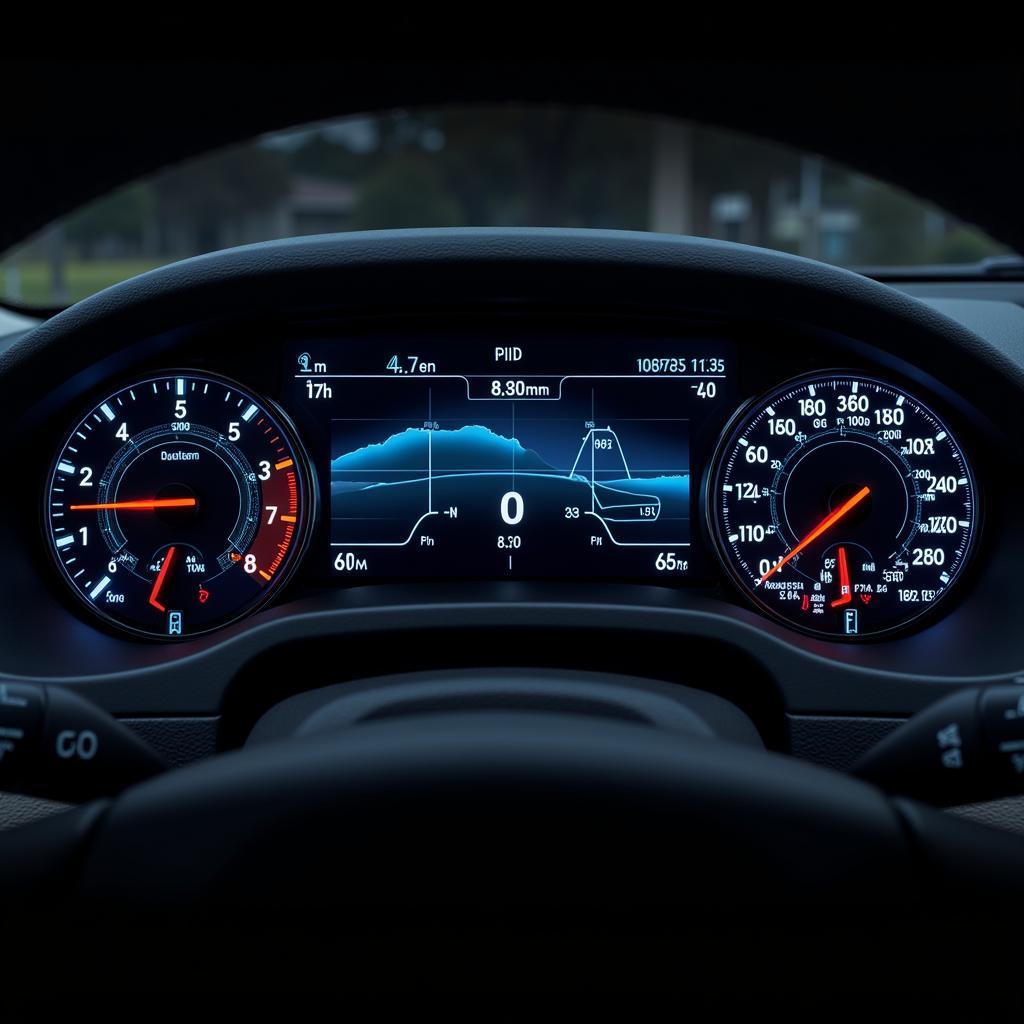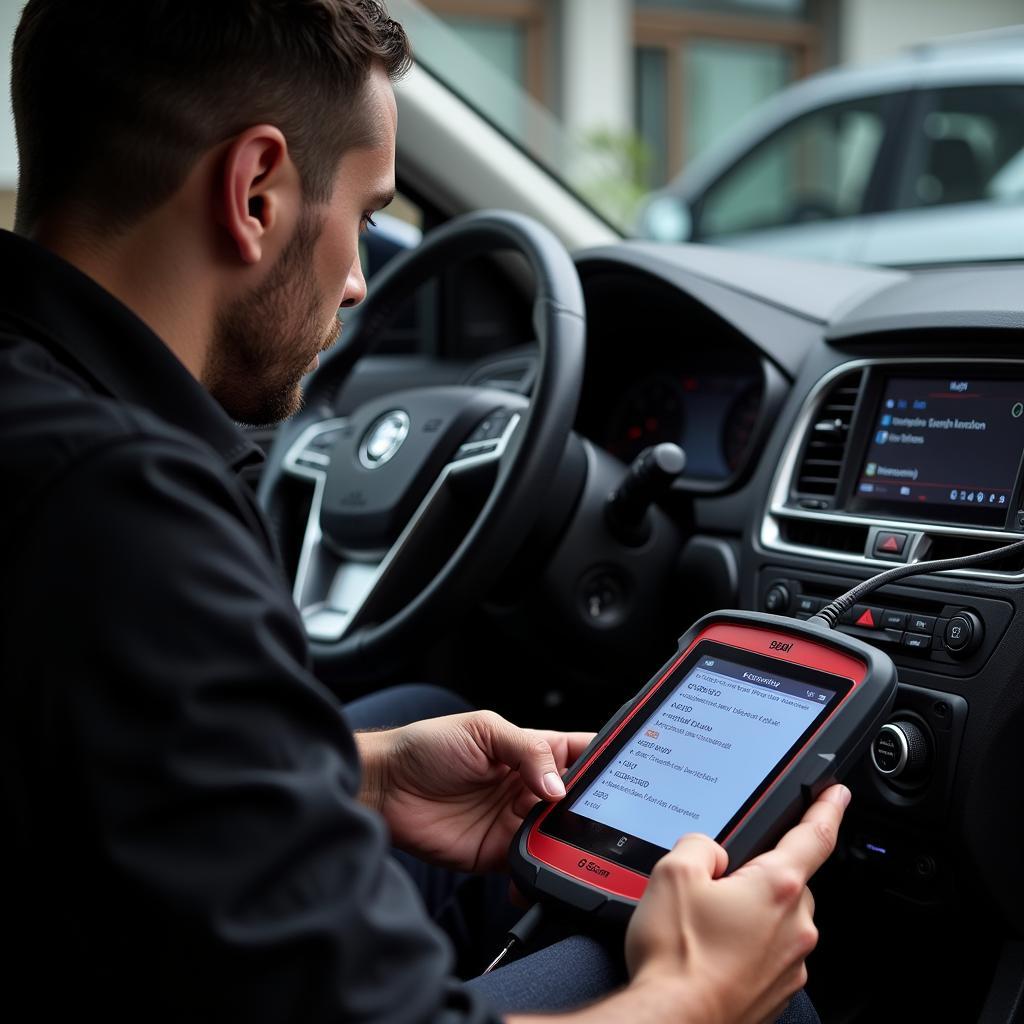A car scanner, particularly one that reads Pid Car Scanner data, can be an invaluable tool for both car owners and professional mechanics. It provides a window into the electronic brain of your vehicle, allowing you to diagnose issues, understand performance metrics, and even preempt potential problems before they become major headaches.
Demystifying the Acronym: What does PID Mean in Car Scanning?
PID stands for Parameter ID. In the context of car diagnostics, it refers to a specific data point that the car’s computer (ECU – Engine Control Unit) monitors and stores. This data can range from engine RPM and coolant temperature to fuel pressure and oxygen sensor readings.
Imagine your car’s ECU as a vast library, and each PID is like a book containing specific information about your vehicle’s operation. A car scanner PID list acts like a library card catalog, allowing you to access and interpret this wealth of data.
 Car Scanner Dashboard Displaying PIDs
Car Scanner Dashboard Displaying PIDs
Why Should You Care About Car Scanner PIDs?
Having access to this data offers numerous benefits:
- Accurate Diagnosis: Instead of relying solely on the check engine light and guesswork, PIDs provide concrete data to pinpoint the root cause of car problems.
- DIY Repairs: With some knowledge of PIDs, car enthusiasts can troubleshoot and potentially fix minor issues themselves, saving on expensive mechanic bills.
- Preventative Maintenance: By monitoring specific PIDs over time, you can spot trends and anomalies that might indicate a developing problem, allowing for timely maintenance.
- Enhanced Performance Tuning: For the performance-oriented, PIDs provide valuable insights into engine parameters, allowing for adjustments and tuning to optimize power and efficiency.
How to Use Car Scanner PIDs Effectively
- Choose the Right Scanner: Not all OBD2 scanners are created equal. To access and interpret PIDs, you’ll need a more advanced scanner that supports live data streaming and PID reading. Some popular options include best scan tools 2015.
- Know Your PIDs: While hundreds of PIDs exist, familiarize yourself with the ones most relevant to your needs or the specific issue you’re investigating. Resources like car scanner pids offer comprehensive lists and explanations.
- Interpreting the Data: Simply reading the data isn’t enough. You’ll need to understand the acceptable ranges for each PID and how different readings correlate with each other. Consult your vehicle’s service manual or reliable online resources for guidance.
“Understanding the language of your car’s computer is empowering,” says John Smith, a senior automotive engineer at ScanToolUS. “PIDs are the key to unlocking a deeper understanding of your vehicle’s health and performance.”
Commonly Used Car Scanner PIDs and Their Significance:
- Engine RPM: Indicates engine speed, useful for diagnosing idle issues or transmission problems.
- Coolant Temperature: Crucial for monitoring engine temperature and detecting potential overheating.
- Oxygen Sensor Readings: Provides insights into the air-fuel mixture, essential for diagnosing emissions problems and optimizing fuel efficiency.
- Mass Air Flow (MAF) Sensor: Measures the amount of air entering the engine, vital for proper fuel delivery and engine performance.
Beyond the Basics: Advanced PID Applications
- Troubleshooting Intermittent Issues: By logging PID data over time, you can capture information even when a problem is not actively occurring, aiding in the diagnosis of intermittent issues.
- Customizing Performance: Advanced users can use PIDs to fine-tune engine parameters, adjust fuel maps, and optimize performance for specific driving styles or modifications.
“With the right knowledge and tools, car owners can use PIDs to take a proactive approach to maintenance and even unlock hidden performance potential,” adds Smith.
Conclusion
The world of PID car scanners might seem daunting at first, but understanding the fundamentals and utilizing the available resources empowers you to take control of your vehicle’s diagnostics and maintenance. Whether you’re a DIY enthusiast or a professional mechanic, harnessing the power of PIDs unlocks a new level of automotive understanding and control.
For expert assistance with your car diagnostic needs, contact ScanToolUS at +1 (641) 206-8880 or visit our office at 1615 S Laramie Ave, Cicero, IL 60804, USA.
FAQs About Car Scanner PIDs:
1. Do I need a special scanner to read PIDs?
Not all scanners can read PIDs. You’ll need an OBD2 scanner specifically designed to access live data streams and display PID information.
2. Where can I find a list of PIDs for my car?
Refer to your vehicle’s service manual or reputable online resources like car scanner pids.
3. Are there any risks associated with using a PID scanner?
As long as you are using the scanner responsibly and not attempting to modify ECU settings without proper knowledge, there are minimal risks involved.
4. Can a PID scanner clear my check engine light?
Yes, most PID scanners have the capability to reset the check engine light, but it’s crucial to identify and address the underlying problem first.
5. Is it worth investing in a PID scanner for personal use?
If you are comfortable with basic car maintenance and want more control over your vehicle’s diagnostics, a PID scanner can be a worthwhile investment, saving you money on mechanic visits in the long run.

